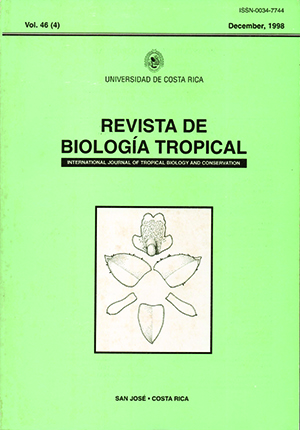Abstract
Eight white-tailed deer were released in La Emilia farm, Guanácaste, Costa Rica, during November 1987 and March 1988. Four females were from an insular population (San Lucas Island, ISL) and had been raised in captivity up to 9 months of age woon they were liberated. The remaining four were adults. three females and one male from Palo Verde National Park (PV). All deer were marked with radio telemetry collars and followed for a 13-month periodo The four deer from ISL were also observed directly for 8 months. The home range and habitat use of each group was determined and compared. The average daily borne range was 18.3 ha for the ISL group and 18.4 ha for tOO PV group; the differences between these values were not significant (Analysis of Variance, ANOVA, P> .05). The home ranges of tOO two groups were not significantIy different between seasons; however the ISL group did show a significant difference between tOO two seasons (ANOVA, P< .05). The ISL group used eight habitat types of the 14 available, while the PV group utilized 11 habitat types; differences were found in tOO habitat preferences between tOO two groups (Xl P< .(01). Habitat utilization was significantIy different between the two groups in both the dry season and the wet season (Xl, P< ,001). The most utilized habitats (confidence intervais of Bonferroni) of the ISL group were grazing land, forest plantations (Pithecelobium saman), cliltivated land (sorghurn and fruits), and riparian vegetation. The PV group used habitats with certain forest cover, chaparral, jaraguales and guacimales (Guazuma ulmifolia).##plugins.facebook.comentarios##

This work is licensed under a Creative Commons Attribution 4.0 International License.
Copyright (c) 1998 Revista de Biología Tropical
Downloads
Download data is not yet available.






